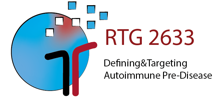MD B1: Testing the effect of kinase inhibitors in the human skin organ culture model
Pemphigus vulgaris (PV) is an IgG-mediated autoimmune disease of stratified squamous epithelia, such as the skin and oral mucosa. IgG autoantibodies are raised against cell-cell adhesion molecules found in desmosomes. The characteristic autoantibodies are desmoglein 1 and desmoglein 3. The pathophysiological effect of these antibodies causes the keratinocytes to separate, a process called acantholysis, resulting in intraepithelial split formation. Subsequently, the clinical picture of the disease predominantly manifests in blistering of the skin and/or the mucous membranes, erosion formation, bleeding and dysphagia. The mainstay of the treatment is based on general immunosuppression: The systemic administration of steroids and latterly monoclonal antibodies, show severe side effects. Hence, further understanding of the fundamental pathogenesis of PV is essential to identify and test more precise treatment options for the disease. My project aims to further identify the role of kinases in intracellular signalling cascades in PV. Therefore, I investigate the dose-dependent effects of seven kinase inhibitors on the development of acantholysis. The experimentally induced PV skin specimens are prepared and harvested within the scope of the human skin organ culture model, previously established within the Hundt lab (Imke Burmester et al., 2019). The model mimics the intraepidermal split formation of PV by injecting a single chain variable fragment. The overall aim is to determine, whether and if so at which concentration effectively, the kinase inhibitors successfully minimize acantholysis compared to the controls. The skin samples are further assessed histologically to quantify the effect.

- Projects
- A: Defining Autoimmune Pre-Disease
- B: Targeting of Autoimmune Pre-Disease
- Associated projects
- MD projects
- Associated MD projects
- Concluded Projects
- PhDs
- Ass. projects
- MDs
- MD A1 - Investigation of the influence of specific CDK inhibitors on neutrophil activation
- MD A2 - Conception of an anatomical expression of landscape of target antigens in autoimmune blistering dermatoses as markers for lesion formation
- MD A3 - Structural characterization of skin-directed autoantibodies and their interaction with the antigen to gain insights into autoimmune pre-disease
- MD A4 - Do interactions between AT1R autoantibodies derived from patients with systemic sclerosis and endothelial cells lead to endothelial dysfunction?
- MD A5 - Optimization and exploitation of a 3D model of human skin for translational use
- MD A6- To study vasculopathy in systemic sclerosis
- MD A7- Identification of autoantibodies contributing to the break of immunotolerance in immunization induced MMP mouse model
- MD A8- The role of AT1R antibodies and extracellular vesicles in mediating endothelial dysfunction in systemic sclerosis with pulmonary arterial hypertension
- MD A9- Impact of glycosylation on IgG4-induced signaling in neutrophils
- MD A10- Testing a new single chain variable fragment for pemphigus foliaceus in the human skin organ culture model
- MD A11- Impact of glycosylation on IgG3-induced signaling in neutrophiles
- MD A12- Screening for inhibitors to prevent keratinocytes dissoziation
- MD A13- Investigation of the local and systemic complement activation in bullous pemphigoid
- MD A14 - Impact of different subclasses on immune complex-induced signaling in neutrophils.
- MD A15 - Novel target antigens as inducers of autoimmunity of autoimmune bullous dermatoses
- MD A16 - Identification of the major epitope of the BP180 ectodomain recognized by serum IgA autoantibodies of patients with pemphigoid diseases –IgA autoantibodies as prognostic marker?
- MD B1 - Testing the effect of kinase inhibitors in the human skin organ culture model
- MD B2 - Cigarette smoking-induced autoantibodies
- MD B3 - Contribution of taurine, hypoxanthine, vitamin B5 and B6 in the pathomechanism of pemphigus vulgaris
- MD B5 - Molecular characterization of the pre-autoimmune effects of Western diet in healthy mice
- Ass MDs







